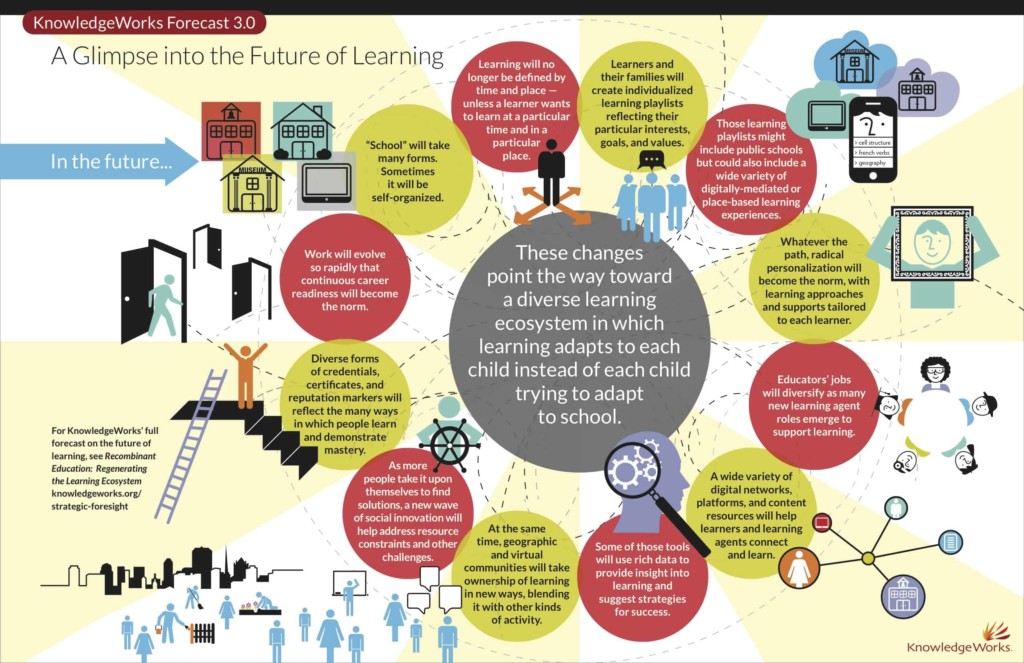10 Elements of Next-Generation K-12 Systems

Across countries, states or regions, next generation elementary and secondary education systems will share ten elements:
1. Goals. Next-generation learning systems will set goals that focuses resources and behaviors on productive habits of success and preparation for participation in college, careers, and civic life. Good goals can encourage Deeper Learning and clarify intent.
Next-gen systems will have standards that express in some detail what students should know and be able to do—more detailed in literacy and numeracy; more general when it comes to dispositions and experiences. They will not include checklists of content knowledge.
2. Assessments. Next-gen systems will use a few common assessments including secondary end of course exams (or demonstration opportunities) available on demand. Providers in next-gen systems will use lots of experience embedded assessments to calculate comparable growth rates. Without heavy weight end of year assessments, it will be easy to determine academic levels and growth rates for each learner in real time.
3. Authorizing. In a next-gen system, all full and part time providers will operate under a performance contract—perhaps three years, longer for proven providers. A well developed provider authorization process would ensures that every family has access to a variety of quality blended and online full and part time options.
Most providers would benefit from perpetual rather than political leadership with a board committed to a mission (i.e., nonprofit and for-profit corporations).
A proactive authorizer seeks providers to address gaps and take advantage of opportunities. For example, the Indiana Charter School Board issued a request for applications that invites new models with strong potential to accelerate student success including those that use “staff roles, technology, compensation structures, and/or other aspects of school design and/or implementation to enable the school to reach more students with excellent teaching” in a financially sustainable model.
Next-gen authorizers will use multiple application pathways for new, innovative, high performing, turnaround, virtual, special services, and conversion providers. (For more on governance, see NCEE’s Tough Choices of Tough Times and Fordham’s report on governance.)
4. Personalized learning. Next-gen systems will power personalization with portable learning plans, transcripts and portfolios.
A decade ago it became widely recognized through the success of a new generation of charters that a coherent model–where everything works together for students and teachers– was key to consistently high achievement. That coherence was usually expressed in high expectations, standards-aligned instruction, formative assessment, and lockstep cohort progress. The next-gen opportunity is a coherent personalized learning experience—individual learning pathways where all the pieces feel purposeful and connected.
Learners will traverse the next-gen multiple provider landscape with Data Backpacks: Portable Records & Learner Profiles and benefit from the sustained relationships of an advisory as well as:
- Single application and enrollment process (e.g., New Orleans’ OneApp)
- Online guidance services (e.g., Louisiana Course Choice)
- Portable digital portfolio (e.g., eduClipper, Pathbrite)
5. Data systems. Next-gen systems support portability, transparency, and accountability with comprehensive longitudinal data systems—that starts with the 10 Elements and Actions of the Data Quality Campaign. As noted in #2 and #4, next-gen systems should provide frameworks for measuring academic growth rates of individual students and facilitate sharable learner profiles and portfolios.
6. Funding. As detailed in Funding Options, Students, and Achievement, next-gen systems will provide weighted, flexible, portable funding.
7. Talent. Next-gen systems will support multiple preparation pathways and certify based on performance. High potential leadership candidates should have access to a variety of developmental experiences and learning opportunities. Next gen schools will recruit, develop, and leverage the talent of great teachers. They will use differentiated roles from assistant to master teacher and will make use of some part time specialists at a distance. See OpportunityCulture.org for 10 specific models of extended reach.
8. Connections. Next-gen systems help secondary students experience success in college, careers, and community service. Post secondary connections will include free competency-based higher education options and access to job training programs as part of or after secondary education.
9. Support. Next-gen systems will connect students to a web of support services for youth and families by partnering with groups like Community In Schools.
10. Accountability. Next-gen systems will actively intervene in chronic failure. Like the Louisiana RSD and the Michigan EAA, the Tennessee Achievement School Districtis the state turnaround district and it’s posting promising results.
The 10 Elements of High Quality Digital Learning from Digital Learning Now! provide additional policy guidance for next-gen systems.
Digital Learning Now! is a Getting Smart Advocacy Partner.




0 Comments
Leave a Comment
Your email address will not be published. All fields are required.